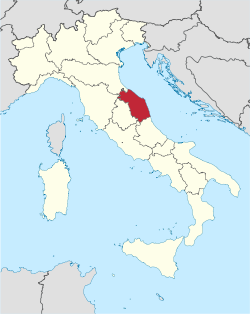Marches of Ancona
| Marche | |||
|---|---|---|---|
| Region of Italy | |||
|
|||
| Anthem: Inno delle Marche | |||
 |
|||
| Country | Italy | ||
| Capital | Ancona | ||
| Government | |||
| • President | Luca Ceriscioli (PD) | ||
| Area | |||
| • Total | 9,366 km2 (3,616 sq mi) | ||
| Population (2012-10-30) | |||
| • Total | 1,541,692 | ||
| • Density | 160/km2 (430/sq mi) | ||
| Demonym(s) | Marchigiano, Marchigiani | ||
| Time zone | CET (UTC+1) | ||
| • Summer (DST) | CEST (UTC+2) | ||
| GDP/ Nominal | €41.7 billion (2010) | ||
| GDP per capita | €26,500 (2008) | ||
| NUTS Region | ITE | ||
| Website | www.regione.marche.it | ||
Marche (Italian pronunciation: [ˈmarke]), or the Marches/ˈmɑːrtʃɪz/, is one of the twenty regions of Italy. The name of the region derives from the plural name of marca, originally referring to the medieval March of Ancona and nearby marches of Camerino and Fermo. Marche is well known for its shoemaking tradition, with the finest and most luxurious Italian footwear being manufactured in this region.
The region is located in the Central area of the country, bordered by Emilia-Romagna and the republic of San Marino to the north, Tuscany to the west, Umbria to the southwest, Abruzzo and Lazio to the south and the Adriatic Sea to the east. Except for river valleys and the often very narrow coastal strip, the land is hilly. A railway from Bologna to Brindisi, built in the 19th century, runs along the coast of the entire territory. Inland, the mountainous nature of the region, even today, allows relatively little travel north and south, except by twisting roads over the passes. The Umbrian enclave of Monte Ruperto (a subdivision of the Comune of Città di Castello) is entirely surrounded by the Province of Pesaro and Urbino, which constitutes the northern part of the region.
...
Wikipedia


